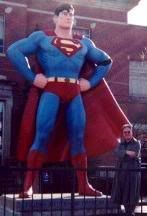| Pop Culture Gadabout | ||
|
Tuesday, May 07, 2013 ( 5/07/2013 10:10:00 PM ) Bill S.  The Larry “Buster” Crabbe serials were adaptations of a classic newspaper Sunday strip, of course. Written by Don Moore and illustrated by Alex Raymond, “Flash Gordon” wasn’t the first sci-fi swashbuckler to appear in newspapers – that honor belongs to “Buck Rogers,” which debuted in 1929 – but it was inarguably the greatest. Credit artist Raymond, who attacked his subject with a detailed fervor unrivaled in its day. Additionally, he was one of the sexiest strippers of his time: whenever an exotic alien princess (and there were a lot of them) set her lusty eyes on blond hunk Flash, you believed it.
British publishing company Titan Books has recently initiated a reprint series of this classic strip; first volume, Flash Gordon: On the Planet Mongo Moore and Raymond’s strip opened in a rush: first panel we see is a newspaper headline trumpeting “World Coming to End” as a strange new planet appears to be on the verge of colliding with planet Earth. When Yale grad and “world renowned polo player” Flash and comely brunette Dale Arden survive a plane crash near the lab of mad scientist Hans Zarkov, the accidental couple are forced to board a rocket designed to deflect the planet from its collision course. (How this actually is supposed to work is never made clear.) The trio land on the planet Mongo, which proves to be as populated with as large a population of feudal humanoids and hybrid creatures as Edgar Rice Burroughs’ Mars. Evil overlord of Mongo, of course, is emperor Ming the Merciless, a “yellow peril” inspired Fu Manchu type who would be a more racist creation if he weren’t established as an alien. Ming instantly lusts for our heroine Dale (“The beauty of the female pleases me. . .”), but muscular Flash quickly seizes the attention of Ming’s daughter Princess Aura, who impulsively follows him down a trap door into a pit packed with “hideous water dragons.” As a Sunday strip, “Flash Gordon” episodically zipped along, typically ending each Sunday with a cliffhanger in the final panel. The structure made it ideal movie serial fodder, though at times reading several months of continuity in a single sitting, you can’t help wishing that writer Moore slowed down enough to tie up all his loose ends. If its storyline ever appears to be finding new ways to unravel, Raymond’s art is a model of control. It truly becomes splendid in the summer of ’34 once he breaks away from the initial four row structure and starts moving in closer to his characters. The larger panels gave the artist room to show off the planet’s varied kingdoms – whether it’s the airborne city of the Hawkmen or an undersea coral kingdom of merfolk – with a grandeur that neither the Depression Era serials nor the Camp Era 1980 feature film could fully capture. Titan Books’ reprint shows off this justly lauded art to good advantage, the one editorial glitch being a duplication of strips on August 18 and 25, 1935, that fortunately doesn’t screw up continuity. It’s a small flaw in a beautifully mounted volume that – had it been available when I was a teen – might’ve kept me from whining about my churchly obligations.
(First published on Blogcritics.) Labels: classic comic strips # | |
|
|

